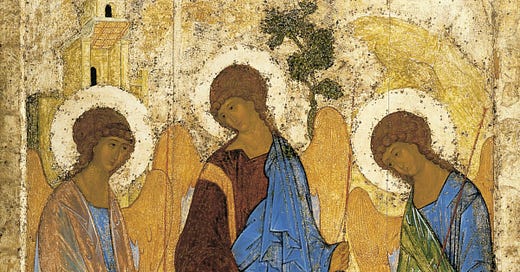This past weekend we celebrated the Feast of the Most Holy Trinity. All Christians hold that the one God we worship is triune, in the persons of the Father, and the Son, and the Holy Spirit.
The fact that we can know God and speak about Him in an intelligent way is incredible. This subject we call God, who is so magnificent that even the seraphim angels are depicted in art as shielding their eyes with their wings in His presence, has deemed it fitting to reveal Himself to humanity.
Yet not only did God reveal Himself to us, but He became one with us, in the person of Christ. It is in Christ that the nature of God has been fully revealed. There is no longer a veil separating God and man, for through Christ, God and man are made one. As St. Paul says in his letter to the Colossians, “Christ is the image of the invisible God.” In Jesus Christ, we come to understand God as a trinity.
So the question is, how? How does one person reveal to us that the one God we worship is a trinity of persons, despite the term “trinity” never appearing in scripture?
Throughout the gospels, Christ constantly refers to Himself and His father as being one. And this unity between the Father and the Son is so strong, that their union—their bond of love—is distinctly personified as the Holy Spirit. Last week on Pentecost Sunday I mentioned how each of the persons of the trinity are, at their heart, relational. Their very names—Father, Son, and Holy Spirit—are ultimately titles that express a relationship.
During the 1970’s and 80’s, there was an effort among some Catholic circles to rename the persons of the trinity according to their roles in history: instead of referring to the trinity as Father, Son, and Holy Spirit, these groups would refer to the trinity as Creator, Redeemer, and Sanctifier. Now while these new names get at the actions of the three persons, they fall short of the persons’ real identities. Again, relationship is at the heart of the three persons in one God.
To break this down, think about what the names “Father and Son” imply. Each name individually implies the other. If a man claims he is a father, then that must mean he has a child—in this case a son. Likewise, every child must have a father.
In this example, we see how the titles “father” and “son” are fundamentally relational—meaning their existence is predicated on being in a relationship with each other. And this relationship—this bond between father and son—is so real, that it is as great as the persons involved. Any loving father knows this: that the bond with his child is so strong, that it is as fundamental as any other reality. And this is where our understanding of the Holy Spirit comes from. The Holy Spirit is that real, tangible love between the Father and the Son.
Ultimately, this is what it means to say that God is Love. God is a union of three persons so bound by love, that they are defined by it, and are one. Which is why we do not worship three gods, but one. And yet, because each person of the trinity implies the other two persons, each one, individually, is fully God. In any relationship, the persons involved do not lose their identities, but rather become more radically themselves, through love.
Now at this point you may be thinking, how does this abstract, trinitarian theology impact my Faith, and how does it practically affect my life?
I’ve heard it said that an artist can be known by his art. If the God who created us is ultimately a union of love, then we too are meant to partake in that love as well. To be a “person” means that our existence hinges on the truth that we are in a relationship.
Remember how in Genesis, when God said, “Let us make mankind in our image”—(and note the plural words, “us” and “our,” hinting at the trinity)—Adam was created, but was unfulfilled until God created Eve. It was only after the man and the woman encountered each other that the author of Genesis wrote, “God created mankind in his image; in the image of God, male and female, he created them.” Then to drive the point home—and truly displaying the symbolism of the trinity in man—Genesis states, “The two of them became one flesh.” The two of them became one flesh.
It is not man in isolation nor woman in isolation that we have an image of mankind; rather it is the two together that makes up who we are as the human race. This is why marriage is such a fitting symbol for the trinity—the two become one flesh, and that love is so strong, that it is personified perfectly through a child. Three persons, united in love.
All of this shouldn’t sound too strange in light of the nature of the trinity. Everything comes from God, and so the pattern of his nature will show up throughout all of creation. Even when we think we are isolated, we cannot help but act as a dim reflection of the trinity. For example, whenever we are deep in thought, it’s like we are having a discussion with ourselves—two persons conversing—and then the ideas we come up with exist as something outside of that inner conversation. Three objects in one subject, not unlike three persons in one God.
Ultimately, once you comprehend this trinitarian pattern, it pops up everywhere. As well it should, for the trinity is not just a fancy idea for us to admire from afar. It dwells within everything that exists. And just as an artist can be known through his art, so can we come to better glimpse at who God is, by being in a loving relationship with others, and with all of creation as well.




